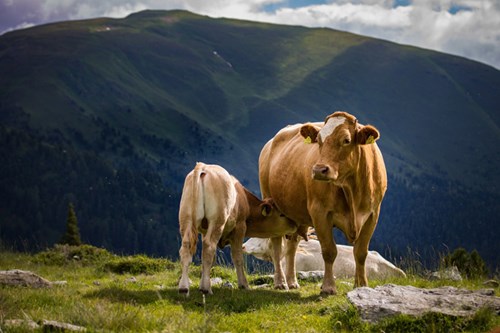Creep feeding Spring-born suckled calves

A feeding calf.
Keeping a tight grip on feed costs is a priority for every beef farmer, but creep feeding suckled calves can be a good return on investment. Maximising the calf’s efficiency at this early stage is becoming much more important with modern market requirements for younger, lighter carcasses. The feed conversion efficiency of calves pre-weaning is the highest it will be at any subsequent period – on average every 3.5-4kg of dry matter feed a calf consumes will result in 1kg of daily liveweight gain.
Why creep feed?
By the time a calf is four months of age half its feed requirement should be met by grass, silage or concentrates rather than milk. At this stage a calf will convert feed to liveweight more efficiently than at any other time in its life so creep feeding to maximise weaning weights will be very cost effective.
- Weaning weights can be increased by around 25kg
- Lowers the weaning check through less stress from weaning – familiarise the calves to a different feed
- Reduced pneumonia after housing (biggest advantage)
- Efficient feed conversion ration – 4kg creep can provide 1kg gain
Weaning is a stressful time for the suckled calf and supplying creep feed before weaning can help smooth the transition from pre- to post-weaning and the extra source of nutrients can compensate for the reduction in milk yield as lactation progresses. When there is less stress at weaning there is a reduced incidence of pneumonia. A further advantage of creep feeding is that the weaning check is reduced because the calf is already familiar with concentrate feed and the rumen microbes are adapted for a change of diet.
Creep feeding is extremely efficient owing to the calf’s high potential growth rate. Since the rest of the calf’s diet (i.e., milk and forage) already more than meets the requirement for maintenance, all the nutrients from the creep are used for growth. This means that the conversion of creep to live weight gain is efficient at around 3-4kg feed/kg gain and is economically worthwhile.
When to start creep feeding
Timing will depend on calf age, growth potential of calves and grass availability. Standard creep feeding would normally start 6-10 weeks prior to weaning but bulls to be finished on ad-lib cereal diets should start being creep fed a bit earlier, around 12 weeks before weaning. With very milky cows or in situations where it is tricky to creep feed starting 4-6 weeks before weaning will still help with the weaning check. A minimum of 3 weeks creep feeding prior to weaning is required. As a rough guide allow 100-150kg of creep feed per calf.
Composition of creep feeds
The creep feed should be 14-16% crude protein and 12.5MJ metabolisable energy/kgDM. It should be palatable and kept fresh. As creep feed is usually made available from a feeder with a hopper it is effectively available ad lib, so care is required to prevent rumen acidosis. Initially the creep feed should be diluted with a digestible fibre source such as sugar beet pulp, citrus pulp, wheatfeed or soya hulls (50/50) and the fibre source gradually reduced over two weeks. It is also advisable to start with a higher protein content (18-20%) as this will also reduce the risk of acidosis. Cereals should be lightly processed – the grain should be just cracked open. Whole oats are an ideal ingredient. Simple mixes of cereal, a protein supplement and a mineral and vitamin supplement will be satisfactory. A superior quality protein source, such as soya bean meal, is particularly useful as it is a source of undegradable protein and will assist the transition to a silage-based diet.
Examples of simple creep mixes would be 1/3 dark grains, 1/3 barley and 1/3 sugar beet pulp with beet pulp gradually reduced by half in favour of more cereals. Another option for a 16% creep blend would be 57.5% barley, 25% beet pulp and 15% soya. Minerals should also be included at 2.5%. To maximise intake, feed must be clean and fresh and creep feeders should be kept topped up to avoid the calves overeating in one session.
Sam Henderson
Sam.Henderson@sac.co.uk

Unearthed is the exclusive SAC Consulting members' monthly newsletter. Unearthed offers insights and tips from our experts on what we think is in store for farming and crofting in the coming months in order to protect and enhance your business.
Posted by Unearthed News on 13/07/2022
